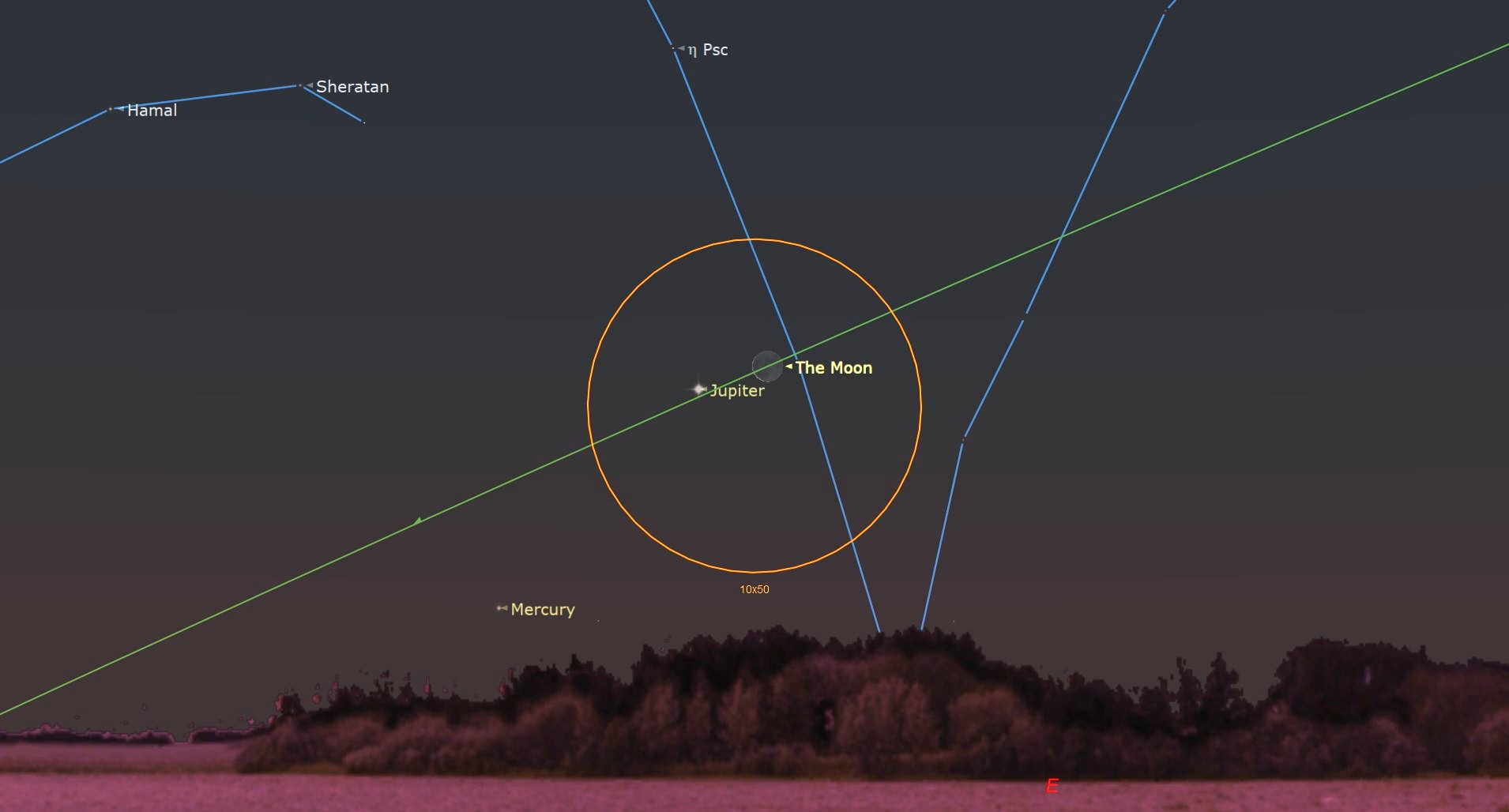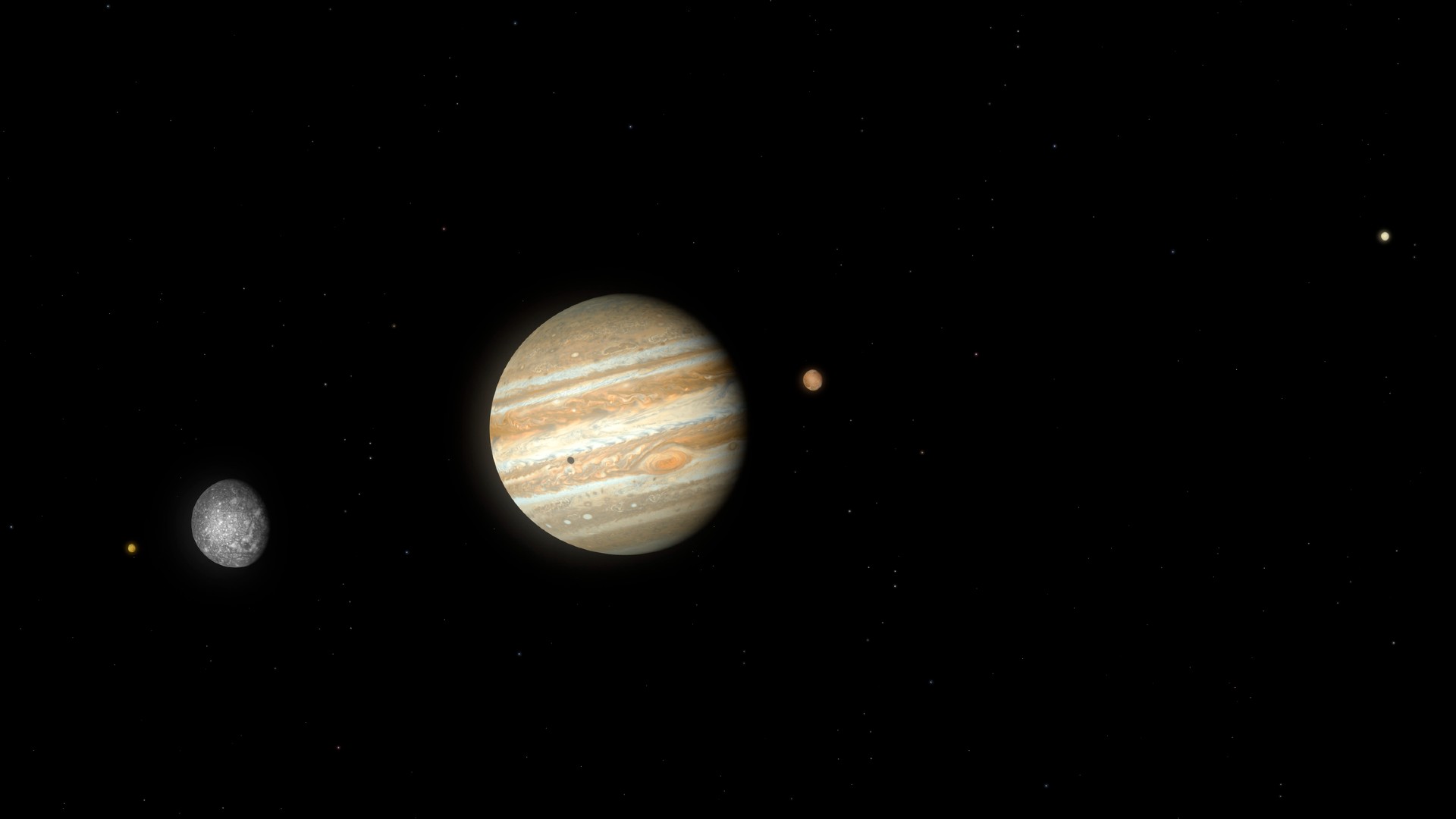See Jupiter hide behind the moon during a lunar occultation early on May 17

The moon and Jupiter will be quite a sight in the early morning skies tomorrow.
Sometime before or after sunrise (depending on where you are) on Wednesday, May 17, gas giant Jupiter and its four bright Galilean moons will pass behind a very thin — only 5% illuminated — waning crescent moon as seen from North America. This occultation can best be watched from the western third of the United States and Canada, where at least part of it happens before sunrise. At locations where it occurs in a relatively dark sky, you might be able to watch Jupiter disappear using no optical aid at all — although binoculars will give a better view, and you will need a telescope to follow its moons.
Jupiter will be covered first by the crescent moon's leading sunlit limb, with the moon requiring a minute or more to inch its way across the giant planet's face. Jupiter will reappear from behind the moon's dark edge about an hour or more later; again, the process will be gradual.
Related: Night sky, May 2023: What you can see tonight [maps]
West is best!

Want to get a good look at Jupiter and its four bright moons in the night sky? We recommend the Celestron Astro Fi 102as the top pick in our best beginner's telescope guide.
The best views of Jupiter's disappearance behind the moon will be from Washington state, Oregon, much of Idaho, Nevada, Utah, Arizona, New Mexico, northern and eastern California and the western half of Texas. For these places, Jupiter and the moon will be positioned low to the eastern horizon against a brightening twilight sky.
Unfortunately, for western and southern sections of California, Jupiter will slip behind the moon prior to moonrise; when the moon first appears above the horizon (for places like San Francisco, Los Angeles and San Diego), Jupiter will already be behind the moon.
As for the reappearance, the western halves of Oregon, Nevada and Arizona as well as all of California are most favored, near and along the Pacific coast of the Golden State, the sun will be about eight degrees below the horizon, while the moon will be a similar distance above the horizon. The emergence of Jupiter from behind the moon's dark limb near mid-twilight could be quite spectacular.
Breaking space news, the latest updates on rocket launches, skywatching events and more!
So far as the Galilean satellites are concerned, they can be glimpsed wherever the sun is at least five degrees below the horizon; the sky should still be sufficiently dark enough to see them with a telescope. Europa will not be visible as it will be immersed in Jupiter's shadow, but Io will be situated very near to Jupiter's eastern limb. Well to the west of Jupiter will be Callisto and Ganymede. In fact, as seen from California, Jupiter's emergence is proceeded by these two satellites by 11 and 7 minutes respectively. Instead of popping out instantaneously like a star, these satellites will "ooze" into view because their disks have an appreciable angular size.
Problematic visibility farther east
Where Jupiter is occulted in broad daylight — and that will be the case anywhere east of a line running roughly from central Montana down to central Louisiana — it will take place against a bright blue sky (assuming the weather cooperates!). But your telescope still may show this interesting event.
Probably the easiest option is to locate the moon and Jupiter before sunrise and track them into the day. About 30 to 40 minutes prior to sunup, look very near to the horizon, slightly north of due east. That's where you will find the slender lunar sliver with Jupiter sitting a degree or less to its left.
The occultation happens during the early morning, with the moon and Jupiter generally being somewhat higher than the sun and well off to its right. If you're search after sunrise, the challenge will be finding the moon and Jupiter at all. Give yourself plenty of time in advance to do this. A lot will depend on the transparency of the sky — in other words, the deepness of its blue color. Point your scope about 28 degrees (nearly three fists-widths at arm's length) from the sun, mostly to the right and, for most locations, about 15 degrees higher.
If you have a "Go-To" telescope mount or a telescope equipped with setting circles, you can be more accurate about it. But remember that the crescent moon will have a low surface brightness that will probably make it hardly distinguishable from the sky itself. Sweep around this region of the sky, then once you've got the moon, the next challenge is Jupiter. Not only will it appear much smaller (a sixtieth of the moon's diameter), but worse, it will have an even lower surface brightness. However, the moon will show you just where to look.
Here's the schedule
We thank the International Occultation Timers Association (IOTA) for viewing data, which was taken from this site, which provides times for 953 different locations within the occultation viewing zone. All times on the site are listed in Universal Time (UT). IOTA also provides information regarding the altitudes of the sun and moon as well as a map depicting the region of visibility. While the moon occults Jupiter in the morning for the U.S., Canada, and Central America, the event will also take place during local afternoon hours as seen from northern Europe.
In the timetable below, we list the local disappearance and reappearance times for 17 selected cities in the U.S., Canada and Mexico. If the time is listed has an asterisk (*), it indicates that the event takes place with the sun below the local horizon. Dashes for disappearance info concerning Los Angeles indicates that the moon is below the horizon for this event.
| Location | Local time Jupiter disappears | Local time Jupiter reappears |
|---|---|---|
| Atlanta, GA | 7:21 a.m. | 8:27 a.m. |
| Austin, TX | 6:13 a.m.* | 7:12 a.m. |
| Boston, MA | 7:45 a.m. | 8:56 a.m. |
| Chicago, IL | 6:36 a.m. | 7:39 a.m. |
| Denver, CO | 5:32 a.m.* | 6:24 a.m. |
| Helena, MT | 5:47 a.m.* | 6:30 a.m. |
| Kansas City, MO | 6:30 a.m. | 7:29 a.m. |
| Los Angeles. CA | ---- | 5:13 a.m.* |
| Miami, FL | 7:11 a.m. | 8:12 a.m. |
| Monterrey, MX | 5:06 a.m.* | 6:04 a.m. |
| Montreal, QC | 7:49 a.m. | 8:59 a.m. |
| New Orleans, LA | 6:13 a.m. | 7:16 a.m. |
| New York, NY | 7:40 a.m. | 8:50 a.m. |
| Seattle, WA | 4:52 a.m.* | 5:28 a.m.* |
| Tucson, AZ | 4:18 a.m.* | 5:11 a.m.* |
| Washington, DC | 7:34 a.m. | 8:43 a.m. |
| Winnipeg, MB | 6:52 a.m. | 7:45 a.m. |
If you are hoping to take a close look at the moon or Jupiter during lunar occultations such as the one happening on May 17, our guides to the best telescopes are a great place to start. If you want to see the two celestial bodies together during events like this one, turn instead to Space.com's guide to the best binoculars, which offer a wider view of constellations, occultations or the entire moon.
And if you're looking to take your own photos of lunar occultations or the night sky in general, check out our guide on how to photograph the moon, as well as our best cameras for astrophotography and best lenses for astrophotography.
Editor's Note: If you snap an image of the lunar occultation of Jupiter and would like to share it with Space.com’s readers, send your photo(s), comments, and your name and location to spacephotos@space.com.

Joe Rao is Space.com's skywatching columnist, as well as a veteran meteorologist and eclipse chaser who also serves as an instructor and guest lecturer at New York's Hayden Planetarium. He writes about astronomy for Natural History magazine, Sky & Telescope and other publications. Joe is an 8-time Emmy-nominated meteorologist who served the Putnam Valley region of New York for over 21 years. You can find him on Twitter and YouTube tracking lunar and solar eclipses, meteor showers and more. To find out Joe's latest project, visit him on Twitter.

